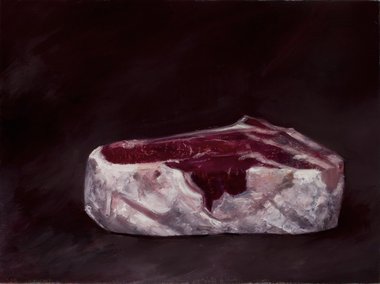Molly Vidor: Oregonian Review

Review: Molly Vidor at PDX Contemporary Art
Published: Wednesday, December 07, 2011, 6:00 PM
By D.K. Row, The Oregonian
Published: Wednesday, December 07, 2011, 6:00 PM
In 1994, Molly Vidor graduated from the Pacific Northwest College of Art and quickly became one of the local art world's emerging stars. One of her first exhibits, a 1996 solo exhibit at PDX Contemporary Art, announced, to much critical hullabaloo, a Young Turk artist trying to revitalize an age-old genre: still life painting.
Now, 15 years later, Vidor's new show of paintings, also at PDX, continues the artist's evolving mastery of still life painting. The artist's technique and commitment once again rise above in this latest exhibit, affirming why so many rightly lavished critical attention on Vidor.
In the show, lilacs, peonies, red dahlias and the occasional gathering of peaches burst from the canvas with color -- lavender, pink, a radiant, sunflower yellow. Sometimes, foreground and background play out a drama of dark shadows, as if from a tranquil but exalted Rembrandt portrait.
In "Red Dahlias," for instance, five wine-red dahlias float in a sea of lightlessness, brooding forms emerging from behind a curtain of black.
Black or gray is the usual backdrop of these paintings. The bouquets of color-imbibed flowers hover somewhere between abstraction and representation -- though mostly closer to representation. Examine the surfaces of these paintings close-up: they're not pristine. Layers are apparent; perhaps other attempted paintings are underneath. There's struggle.
When a young painter pursues something as conventional -- even conservative -- as still life painting, there's a tendency to expect revolution because the perception is that young artists like to interrogate tradition.
But Vidor does not care about revolution. Or perfection. These paintings work well as traditional still life paintings, even comfortably so.
Instead, the layers of gritty struggle tell us Vidor's trying to connect to the craft of making things. She cares more about the intimate connection between observing a bouquet of dahlias or peonies and then interpreting them. Her paintings aren't powered by hidden, eloquent metaphors. These aren't complicated paintings in that sense.
So, what are these paintings about at a deeper level?
A painting is often a document of a journey the artist took that day or week or month, with the finished artwork a visual capsule of that pilgrimage. And the artist's career is a collection of countless such journeys, one filled with twists, turns and unexpected excursions. Vidor has had many of them.
Sometime after she became one local artist to watch -- someone of whom big things were expected -- Vidor semi-disappeared from the art scene. She exhibited only occasionally. Often, I'd see her around town, at an opening, say. Always, she seemed in good spirits but also distracted from a familiar focus -- maybe the focus the rest of us in the art world intended for her.
Whatever the case, I detected in her a disconnect from her gift. I say that with a touch of regret: We should have been seeing more of this promising painter.
Now approaching middle age, Vidor is at once back where she started but also well advanced from that start. She's showing more regularly. And she's painting still lifes -- but a tad differently.
One painting, of a slab of raw steak, reveals the same struggle to achieve balance between abstraction and representation as those pretty flowers, the same vigorous application of paint using brush and other tools. But the blunt subject matter tints the painting with a funny, queer poetry.
It's heartening to catch Vidor in the middle of her journey. I look forward to seeing the succeeding chapters more continuously.
D.K. Row